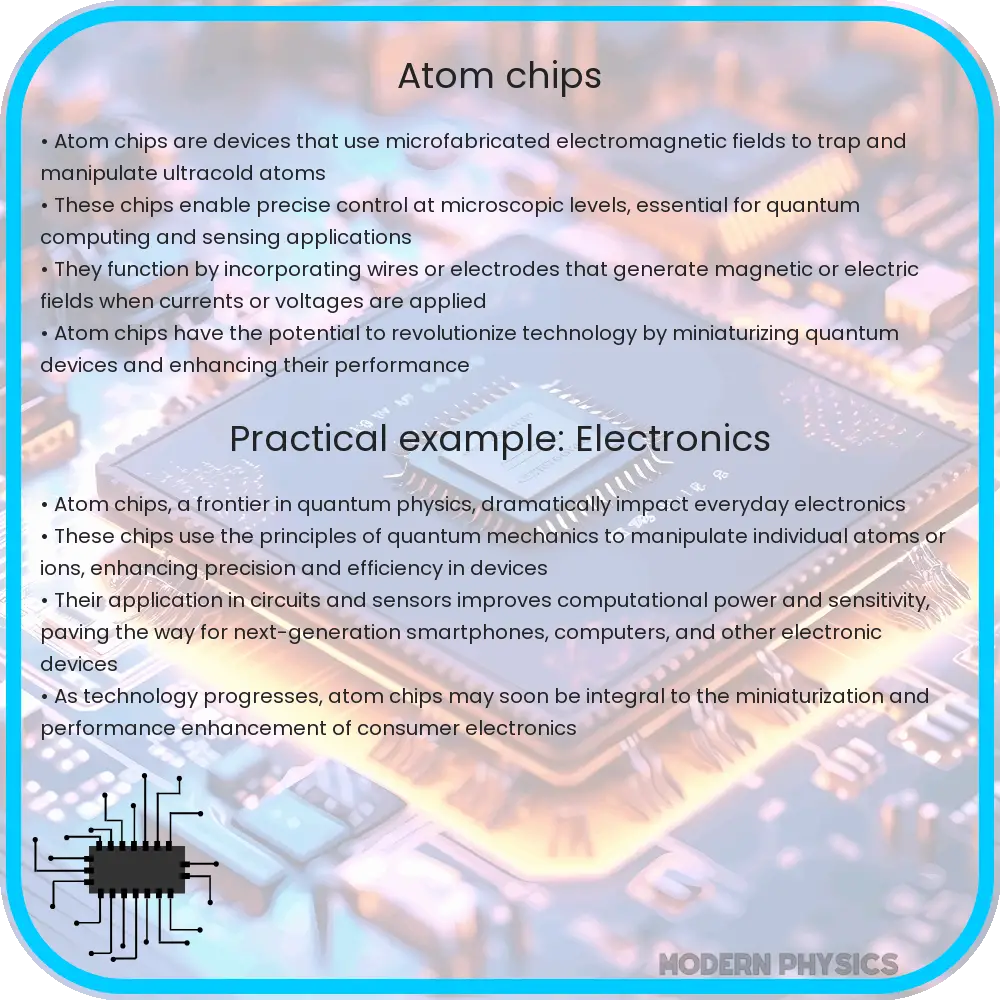Atom chips are devices that control atomic quantum states using microfabricated structures for applications in quantum computing and sensing.

Introduction to Atom Chips
Atom chips are a groundbreaking technological advancement that stands at the captivating intersection of quantum physics and microfabrication technology. These devices harness the unique properties of atoms at microscopic scales, enabling the manipulation and control of atomic quantum states. Atom chips have the potential to revolutionize fields such as quantum computing, precision sensing, and fundamental quantum research.
Principles of Atom Chips
The core principle behind atom chips involves the manipulation of atoms using magnetic or electric fields, which are produced by microfabricated structures on the chip. These chips typically consist of a substrate material, like silicon or gallium arsenide, onto which metallic or magnetic materials are deposited to form intricate circuits. These circuits create potentials that can trap and guide ultracold atoms in various configurations.
One fundamental concept in the operation of atom chips is the use of Zeeman effect, which describes how a magnetic field can split atomic energy levels. This effect is crucial for trapping atoms in specific quantum states. By precisely controlling the magnetic fields, atom chips can hold and manipulate atoms with an exceptional degree of control.
Uses of Atom Chips
- Quantum Computing: Atom chips provide a platform for quantum bits (qubits), which are the basic units of quantum information. The precise control of atomic states allows for the implementation of quantum gates and algorithms.
- Precision Sensing: The sensitivity of atoms to their surrounding environment makes atom chips excellent for sensors. Applications include measuring magnetic fields, gravitational forces, and time (in atomic clocks).
- Fundamental Quantum Research: Researchers use atom chips to study Bose-Einstein condensates, quantum entanglement, and other phenomena, pushing the boundaries of our understanding of quantum mechanics.
Technology Behind Atom Chips
Atom chips are fabricated using techniques similar to those used in the semiconductor industry, such as lithography, etching, and deposition. These processes allow for the creation of features as small as a few micrometers or even nanometers, which are essential for generating the precise electromagnetic fields needed for controlling atomic particles. Additionally, because atom chips operate under ultra-cold conditions, much of their design is also focused on integrating with cryogenic systems to achieve temperatures close to absolute zero.
The interfacing of quantum systems with practical electronic circuits introduces challenges, especially in shielding the quantum elements from environmental noise and achieving high-fidelity quantum operations. Innovations in material science, electronic engineering, and quantum physics are continually advancing the functionality and reliability of atom chips.
Current Research and Developments
Research in the field of atom chips is vibrant and continuously evolving. Scientists are exploring ways to enhance the coherence times of quantum states on atom chips, which is crucial for longer computational processes in quantum computing. Another area of intense research is the integration of optical components directly onto atom chips, aiming to create a more compact and efficient quantum optical system.
Recent advancements also include the exploration of novel materials and designs that can reduce noise and increase interaction times between atoms, thereby improving the precision of quantum measurements and the stability of quantum states.
Future Prospects and Challenges
If we wish to see atom chips move from research laboratories to practical applications, several technical and engineering challenges need to be overcome. These include scaling up the number of qubits for practical quantum computing, improving the integration with existing technologies, and enhancing the chips’ durability and operational stability under real-world conditions.
The exploration of new substrates, such as graphene or topological insulators, presents an intriguing pathway to potentially overcome some of these challenges, introducing properties that could fundamentally enhance the performance and capabilities of atom chips.
The journey of atom chips from a fascinating scientific concept to a cornerstone technology in the next generation of computing and sensors is replete with both challenges and opportunities, driving forward both our technological landscape and our understanding of the quantum world.
Educational and Commercial Impact
The development of atom chips not only pushes the boundaries of quantum physics and engineering but also offers substantial educational value. As these technologies become more widespread, they provide an excellent platform for training the next generation of physicists and engineers, familiarizing them with quantum technologies that are likely to be crucial in the future.
From a commercial perspective, the potential markets for atom chips extend beyond quantum computing. Industries such as healthcare, for enhanced imaging systems, and telecommunications, for secure communication channels, could greatly benefit from advancements in this technology. Additionally, as quantum sensing technologies mature, sectors like geology and navigation could see revolutionary changes in how measurements are performed.
Conclusion
In conclusion, atom chips represent a remarkable fusion of quantum mechanics and microfabrication technology. By controlling atomic states to an astonishingly precise degree, these devices open new avenues in quantum computing, precision sensing, and fundamental research. While there are challenges to overcome, particularly in terms of scalability and integration with conventional technologies, the ongoing research and development promise to address these hurdles. Whether enhancing the capability of qubits for quantum computers or refining the sensitivity of quantum sensors, the trajectory of atom chips is poised to make a significant impact on various scientific and industrial fields. The journey of atom chips, from intricate laboratory experiments to integral components of cutting-edge technologies, continues to inspire and challenge scientists and engineers around the globe.
